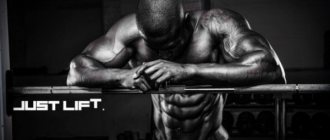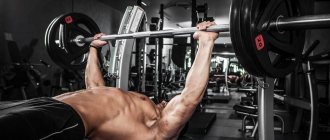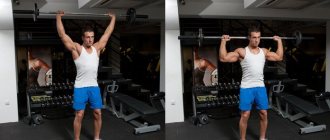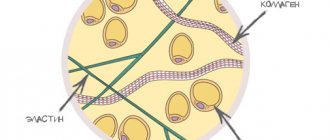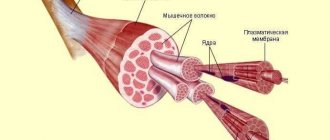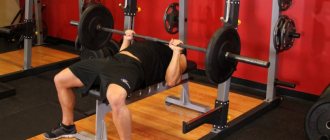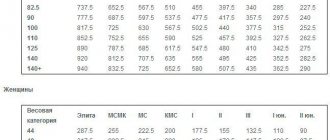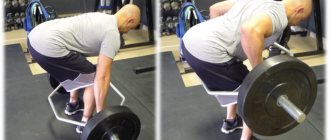The mechanisms for overcoming “dead zones” in the bench press are considered from the point of view of biomechanics. It has been shown that unfavorable conditions that reduce the speed of the barbell in the first “dead zone” are: small values of the leverage of the traction force of the pectoralis major and deltoid muscles relative to the shoulder joint and sufficiently large values of the gravity force of the barbell. An unfavorable condition that reduces the speed of the barbell in the second “dead zone” is insufficient strength of the forearm extensor muscles.
Samsonov, G.A. Overcoming “dead zones” when performing bench press / G.A. Samsonov, N.B. Kichaikina, B.I. Sheiko // Scientific notes of the P. F. Lesgaft University, 2020, No. 10 (128).- P. 171-176.
UDC 796.012.464:611.738
How to Bench the Bench Press
There are 2 ways to bend on the bench press: The first method is to take the bar and throw yourself forward onto straight arms. Place your shoulder blades on the bench (arms straight, triceps tense), lift your buttocks and, moving your legs, push your body towards the bar. At the same time, the deflection in the back increases, the arms gradually bend. Do this until your back hurts. Place your feet either on the ribs or on the soles, firmly, as close to your head as possible so that the bridge does not move apart.
The second method is exactly the opposite. You go behind the bar, take the bar, fix your legs, firmly, close to the racks. Throw your body forward, belly up and fix your shoulder blades.
Train the bridge! During training, get into a bridge from a lying position. 6 sets of 20-30 seconds. Having pre-warmed up, with each approach try to place your feet closer to your head. Each time you lie down under the barbell, devote 5-15 seconds to deflection. It doesn’t matter if it’s 20 or 200 kg.
Before any bench press workout, bend your back on the bar for 1-3 minutes. Just come up, sit on the bench with your back to the bar, and your partner bends you back by your shoulders. Raise the bar from zero to 2-3 positions to arch your back in different positions.
Let's start looking at the technique of doing the bench press with the technical rules.
Dropping wrists
When performing the bench press, do not let your wrists bend back; the bar should be in the same plane as your forearms. By allowing your wrists to drop, you create the conditions for medical problems to arise, and the working weight in this position of the hands is not in line with the points of maximum application of force.
Need an illustration? Keep your wrists clenched tightly, as if you were hitting a punching bag.
The bar should be in the same plane as your forearms.
Bench press (rules and procedure)
- The bench should be located on the platform with its front (head) part parallel or at an angle of no more than 45 degrees relative to the front side of the platform.
- The athlete should lie on his back, with his shoulders and buttocks in contact with the surface of the bench. The sole and heels of his shoes must be in contact with the surface of the platform or blocks. The fingers should clasp the bar lying on the racks. In this case, the thumbs are located “locked” around the fingerboard. This body position must be maintained throughout the exercise.
- To ensure firm support for the legs, the athlete can use flat slabs or blocks no higher than 30 cm from the surface of the platform. At all international competitions, blocks of 5, 10, 20, and 30 cm in height must be provided for placing under the feet. Light or very slight movements of the feet while on the platform or blocks are allowed.
- During the bench press, there should be no more than 3 and no less than 2 spotters (assistants) on the platform. After the athlete independently takes the correct position to start, he can ask assistants to help him remove the barbell from the racks. In this case, the barbell is fed to straight arms.
- The distance between the hands on the bar, which is measured between the index fingers, should not exceed 81 cm (both index fingers should be inside the 81 cm marks). In the case where an athlete has an old injury or is anatomically unable to grasp the bar at the same distance with both hands, he must warn the judges about this in advance before each approach. In this case, if necessary, the barbell will be marked accordingly before each approach of the athlete. The use of a reverse grip is prohibited.
- After removing the bar from the racks with or without the help of assistants, the athlete must wait for the signal from the senior judge with his arms fully straightened (“on”) at the elbows. The signal to begin the press should be given as soon as the lifter is stationary and the bar is in the correct position. For safety reasons, the referee may ask the lifter to return the barbell to the racks by giving a clear command to “replace” with a simultaneous movement of the arm backwards if, within five seconds of removing the barbell from the racks, he has not been able to assume the correct starting position to begin the lift. .
- The signal to start the exercise is a downward movement of the hand along with a clear command “start”.
- After receiving the signal, the athlete must lower the barbell to his chest and maintain it in a stationary position on his chest with a certain and visible pause. Standing still means stopping. It is recommended to apply the “one second rule,” that is, hold the barbell on your chest for a count of “one.” Then the athlete must press the barbell up onto straight arms without excessive (too strong) uneven straightening of the arms, and the straightening of the arms at the elbows should occur simultaneously (together). After fixing the bar in this position, the head judge must give a clear command to “rack” while simultaneously moving the arm back.
- If anatomically both arms cannot be fully straightened, the athlete must warn the judges about this in advance before each approach.
Reasons why weight lifted on a bench press does not count
- Failure to comply with the senior referee's signals when starting or finishing an exercise.
- Any change in the starting position during the exercise, i.e. any lifting (separation) of the shoulders, buttocks from the bench or feet from the surface of the platform (blocks), or movement of the hands along the bar. Light or minor movements of the feet are allowed. Toes and heels must remain on the surface of the platform (blocks).
- Raising and lowering, bouncing, or moving down (pushing into the chest) the barbell after it has been secured in a stationary position on the chest in a manner that assists the lifter.
- Any obvious (excessive) uneven extension of the arms during the press.
- Any downward movement of the barbell during a bench press.
- Lack of squeezing the barbell with fully straightened arms at the end of the exercise.
- Touching the barbell or the athlete by spotters (assistants) between the signals of the senior referee to facilitate lifting the barbell.
- Any contact of the athlete's feet with the bench or its supports.
- Failure to comply with any of the requirements contained in the description of the rules for performing the bench press.
Too much weight
This chronic infection has affected all the gyms on the planet. I have to stop myself from yelling, “Are you doing the bench press or are you helping the spotter do the upright row?”
If you are helping a partner, don't let the bar stop.
Trying to finish a set of 8 reps with a weight that you can only lift twice without assistance? Take it easy, buddy, literally take it easy! You must do one, maximum two repetitions with the help of a spotter, and before that at least five on your own; It is only for these two final movements that an assistant is needed.
And if you're helping a partner, don't let the bar stop. Always maintain the forward movement of the projectile towards the top point.
Phases of performing the bench press exercise
First phase . The pre-start position technique consists of: a) the athlete’s position on the bench (back arch, leg placement); When positioned on a bench, the athlete should try to arch his back as much as possible, keeping his shoulders and buttocks in contact with the bench. Since January 2001, technical rules have allowed lifting your head off the bench.
The more the athlete arches his back, the shorter the distance of the barbell, and therefore the less physical effort. Moreover, the height of the bridge can be limited only by the flexibility in the lumbar and thoracic regions of the athlete’s body, since the height of the bridge is not limited by the competition rules. At the same time, you should try to pull your shoulders as close to the pelvis as possible.
The athlete’s first point of support in this position is the neck and trapezius, the shoulder blades should be brought together and should not touch the bench, the shoulders should be lowered as far as possible. The muscles of the legs and back are in a tense state, the pelvis should touch the bench, but not lean on it. The second fulcrum is the athlete’s legs.
At the moment, it is very important at what height the barbell is located. It should lie on the racks at a height at which the athlete can accept the barbell from an assistant without breaking the bridge. If the barbell rests high on the racks, the athlete will have to reach for it and the arch in his lower back will decrease, which will increase the length of the press. If the barbell is in a low position on the racks, the athlete will not be able to bend to its full extent and will have difficulty removing the barbell from the racks. b) grip of the barbell; The fingers should clasp the bar lying on the racks. In this case, the thumbs are located “locked” around the fingerboard.
Basically, powerlifters use 2 grips:
- wide (81 cm), the maximum allowed by the competition rules, in which the main load falls on the pectoral muscles
- medium grip (70-75 cm wide), which more strongly engages the triceps and deltoid muscles, depending on the length of the arms and the strength potential of the athlete’s pectoral muscles.
Because all athletes have different body structures, limb lengths, and strength areas, the ideal grip width may be different for everyone. But nevertheless, the axiom is the same for everyone: the wider the grip of the hands (but not more than 81 cm), the shorter the path of movement of the barbell from the chest and, as a result, the physical work performed by the athlete will be less. And vice versa, the narrower the grip of the hands, the longer the path of movement of the barbell, and the physical work performed will be greater.
We also must not forget that the wider the grip of the hands, the greater the load placed on the pectoral muscles, and the narrower the grip, the more the triceps and deltoid muscles are loaded. The anterior lobe of the deltoid muscles should be below the line of the pectoral muscles.
c) removing the bar from the racks. The lifting of the barbell is carried out by the athlete independently or with the help of assistants. Recently, at all international competitions, one assistant in the center helps remove the barbell. Receiving the barbell from the assistant from the racks, the athlete slightly raises the pelvis, brings the barbell forward and lowers it as far as possible with straight arms, by bringing the shoulder blades together and lowering the shoulders down, then lowers the pelvis until it touches the bench.
d) position of the legs. The feet should be placed as close as possible to the vertical projection of the pelvic girdle. The leg muscles are in a tense state. The athlete must stand on his feet and only touch the bench with his buttocks. This practice helps stabilize the entire body, and the muscles involved in the exercise work more efficiently. Wide-legged positions are just as common as close-legged positions, but both positions involve elements of “closing” the body on the bench.
Second phase . Starting position. After receiving the barbell from the assistant, the athlete fixes the barbell in a stationary state with his arms fully straightened at the elbow joints and waits for the senior judge’s “start” signal.
Third phase . Lowering the barbell to the chest. After the senior judge’s signal, the athlete lowers the barbell to his chest. Lowering the barbell to the lower edge of the pectoral muscles should be carried out relatively slowly, with full control of the tension of all muscle groups involved in the movement. In this case, the athlete makes a counter movement with his chest towards the bar, without lifting the support points of the body from the bench. The angle between the shoulder and torso is approximately 45 degrees both when lowering the barbell and when pressing it from the chest. Lowering the barbell to the chest and pressing from the chest is performed while holding your breath.
Fourth phase . Fixing a pause with a barbell on the chest. After receiving the signal from the senior judge, the athlete must lower the barbell to his chest and hold it in a stationary position on his chest with a certain and visible pause. Standing still means stopping.
Fifth phase . Barbell bench press. a) tearing the barbell off the chest; After the barbell has visibly stopped on the chest, the athlete puts maximum effort into the muscles that directly perform the press - the pectoralis major, deltoids, triceps and lats.
With the so-called “chest” style of pressing, the shoulders of the arms should be perpendicular to the body, while getting maximum benefit from the inclusion of the anterior deltoid muscles in the work. When performing a triceps press, the elbows should be moved slightly closer to the body.
The initial impulse to tear the barbell from the chest is also given by the latissimus dorsi muscles, moving the athlete’s shoulder joints forward. With the “chest” style, the bar moves almost vertically with a slight deviation towards the racks; with the “triceps” style, it moves backwards from the vertical plan. A powerful exhalation is made in the upper third of the press, almost when pressing with straight arms.
Some athletes, when lowering the barbell to their chest, tense their pectoral muscles and relax their arm muscles a little. They explain that this is necessary to ensure a sharp release from the chest, a small acceleration, which is achieved by relaxing and then sharply tensing the latissimus dorsi muscles, immediately engaging the pectoral muscles, deltoids and triceps. Other athletes, when placing the barbell on their chest, do not relax their arm muscles, so they cannot suddenly pull the barbell off their chest.
When an athlete lifts the barbell from his chest, the movement at this moment should go from the legs (by tensing them) towards the head, but in no case upward, otherwise the pelvis will be separated from the bench.
The bar should move approximately vertically upward, with a slight slope towards the racks. We must try to ensure that the bar does not move strictly vertically upward or towards the legs, this excludes the deltas from working.
b) passing the “dead point”; The height and time of manifestation of the “dead spot” are purely individual for each athlete. Their values depend on the qualifications of the athlete, gender, and the percentage of the weight of the equipment to the individual maximum result in the bench press. It has been established that with increasing qualifications of athletes, in competitive conditions, a more pronounced “dead point” is observed. This fact is probably due to the weight of the projectile approaching the record result of a certain athlete.
The time for the manifestation of this zone from the GP between the 4th and 5th phases is on average 0.4 - 1.2 s. Depending on the anthropometric characteristics of the lifter, the distance from the chest at this time is 11–18 cm.
c) we'll push it. During the final part of the press, (approximately in the upper third of the press), it is recommended to exhale powerfully and sharply. Straightening your arms at the elbows should occur simultaneously.
Sixth phase . Fixing the bar in the final position with straight arms, until the senior judge’s command “on the racks” - (“rack”). After full and simultaneous straightening of the arms, the athlete fixes the barbell in a stationary position and waits for the senior judge’s signal to “rack”.
Seventh phase . Returning the barbell to the racks (after the senior judge’s command “rack”). After the senior judge’s signal, the athlete returns the barbell to the racks independently or with the help of assistants by shifting the center of gravity of the projectile, located in the straightened arms, back, for the vertical projection of the athlete's eyes.
Bridge training
For professional athletes in this sport, bridge training is of great importance. You should devote no less time to it than to doing the bench press itself.
The difficulty is that pumping muscles steals their elasticity. Therefore, athletes should do stretching after each session, especially the muscle corset.
The height of the deflection depends on this, and therefore the time after which fatigue sets in. To train the bridge, various yoga exercises are used. The “Cobra” pose is especially important, in which the athlete tries to achieve maximum deflection of the lower back, resting his outstretched arms on his legs lying on the floor with his knees down.
In competitions, the bridge is used not only to reduce distance. The athlete has 3 points of support: shoulder blades, tailbone and legs, standing almost under the back. This makes it possible to absorb enormous weight with the whole body.
Errors in Competitive Bench Press Technique
- Uncentered grip on the projectile bar ; may lead to misalignment and, as a consequence, to uneven squeezing of the bar, which is prohibited by technical rules;
- “open” grip of the bar ; due to the risk of injury, this grip is prohibited by technical rules;
- positioning the head too close to the posts ; if you lie on the bench so that the bar is below your eye line, then when you press the barbell you can hit the racks, which will lead to unnecessary friction of the bar on the racks or stopping the barbell;
- non-optimal angle of flexion of the legs at the knee joints ; a non-optimal angle of leg flexion can lead to relaxation of the back muscles and a decrease in deflection (bridge), which will lengthen the path of the barbell and increase the athlete’s effort;
- failure to maintain a stationary position on the chest (pause), beating the bar off the chest ; pressing the barbell without a visible stop of the barbell on the chest, or pressing the barbell on the chest without stopping or beating the bar off the chest is prohibited by the technical rules of the competition;
- incomplete “turning off” of the hands at the end point of the press ; Not completely turning off your hands is prohibited by technical rules. If anatomically both arms cannot be fully straightened, the athlete must warn the judges about this in advance before each approach.
- lifting the heels after the start of the press ; lifting the heels after the start of the press is prohibited by technical rules;
- separation of the pelvis from the surface of the bench ; lifting the pelvis from the surface of the bench is prohibited by technical rules.
695 5
